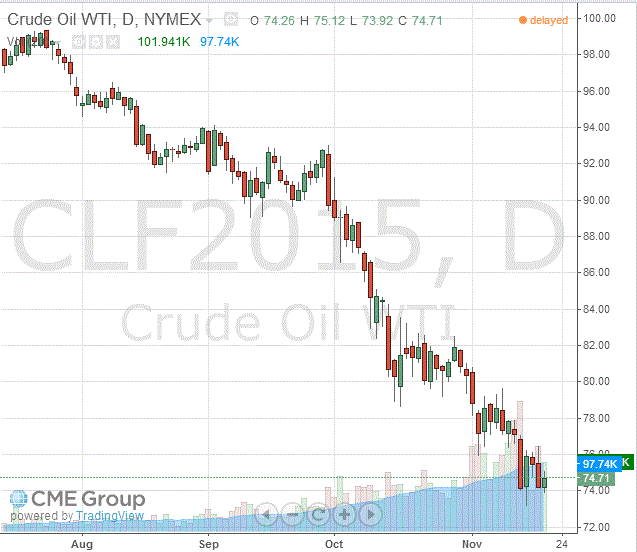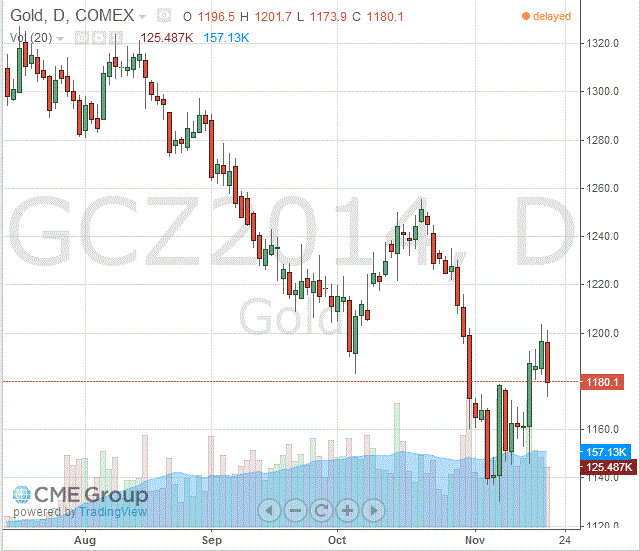Notícias do Mercado
-
23:37
Commodities. Daily history for Nov 19’2014:
(raw materials / closing price /% change)
Light Crude 74.26 -0.43%
Gold 1,181.60 -1.03%
-
16:40
Oil: A review of the market situation
The price of oil rose moderately, closer to $ 79 (Brent) and $ 75 (WTI) amid speculation that OPEC may take measures to stabilize prices, which have fallen by almost a third in five months.
It is worth emphasizing that the oil ministers of Saudi Arabia and Kuwait are opposed to the reduction of production, while Libya, Venezuela and Ecuador are insisting on the adoption of measures to prevent further price declines. OPEC oil ministers scheduled a meeting in Vienna on November 27, during which intend to consider whether to adjust the current volume of production at 30 million. B / d at the beginning of 2015.
"Agreed to reduce production will be difficult. I think that the market does not believe in it, and even if OPEC said it was ready to cut production, I think many would react skeptical, "- said a senior strategist at CMC Markets in Sydney, Michael McCarty.
Meanwhile, today the head of the Energy Information Agency of the Ministry of Energy of the United States allowed the fall of Adam Seminsky world oil prices to $ 50 per barrel. He also said that according to forecasts of most analysts, WTI crude oil falls to $ 62 per barrel by mid-2015. With oil prices at $ 60 per barrel increase in the production of shale oil in the US may stop Seminsky added. However, to accurately predict the cost of oil Seminsky not. Predict the price of oil prevented the geopolitical problems and conflicts in Libya, Iraq and other countries.
The course of trade also affected the data on oil reserves in the United States. The Department of Energy reported that commercial oil reserves in the vaults of the United States during the week of 8-14 November rose by 2.6 million barrels to 381.1 million barrels, while the average forecast assumed their fall by 1 million barrels. Stocks rose to a maximum of 4 July. Oil reserves in Cushing terminal rose to 23.2 million barrels, the highest level since May 9. Gasoline inventories rose by 1 million barrels to 204.6 million barrels. Analysts expected gasoline supplies to increase by 600,000 barrels. Distillate stocks fell by 2.1 million barrels to 114.8 million barrels, the lowest level since May 9, while analysts had expected a decrease of 1.4 million barrels.
Utilization rate of refining capacity rose to 91.2%. Earlier, analysts expected an increase in the index by 0.3 percentage points.
We also recall that yesterday after markets closed the American Petroleum Institute reported that US crude stocks rose 3.7 million barrels for the week ended November 14th. The report also showed that gasoline inventories rose by 519,000 barrels, while distillate inventories decreased by 3.3 million. Barrels.
Cost of January futures for US light crude oil WTI (Light Sweet Crude Oil) rose to 74.70 dollars per barrel on the New York Mercantile Exchange.
January futures price for North Sea petroleum mix of Brent rose $ 0.36 to $ 78.76 a barrel on the London Stock Exchange ICE Futures Europe.
-
16:20
Gold: a review of the market situation
Gold prices fell markedly, while losing about 1.5 percent, due to the expectations of the Fed's publication of the protocol, as well as the approach of the Swiss referendum on gold, which is scheduled for next week.
Experts point out that if the protocols are not will signal to strengthen the tendency to tighten policy, and inflation will decline, gold is likely to continue to strengthen.
But in the short term, gold prices are likely to remain vulnerable amid signs that the strengthening US recovery could force the Fed to start raising interest rates earlier and more sharply than expected. Expectations of growth rates on loans put pressure on gold as a precious metal with difficulty competing with the yield of interest-earning assets at higher rates.
Had little effect as today's data on the US housing market. It is learned that the establishment of new homes fell 2.8% in October compared with a month earlier and to a seasonally adjusted annual rate reached 1,009,000 units. The fall was due to a decrease in construction mnogkvartirnyh homes - a category that provides a smaller contribution to economic growth, rather than single-family homes. Building permits (an indicator of future construction) increased by 4.8% last month - to the level of 1.08 million units. Economists had expected the establishment of new homes will rise by 0.8% last month, while building permits increase by 0.6%. September bookmark new homes revised up to an annual rate of 1.038 million, showing an increase of 7.8% from August. The initial reading is intended to increase by 6.3%. September building permits have not been revised and made 1.031 million units.
The value of the precious metal is also affected by the change in the US currency. Add the dollar to a basket of six major currencies rose due to falling yen to seven-year low. "It looks like it was another short covering, as the price does not hold above $ 1,200. The dollar remains the main factor affecting the price "- say experts.
The cost of the December gold futures on the COMEX today fell $ 17.7 to 1180.10 dollars per ounce.
-
11:20
Oil: Brent Crude up – WTI down
Oil prices are mixed in today's session with Brent Crude trading +0.29% at USD78.70 a barrel and West Texas Intermediate Crude losing -0.20% currently quoted at USD74.46. Brent Crude rose after a car bomb exploded in Iraq, OPEC's second largest oil producer. Oil prices are still under pressure amid weakening global demand and the OPEC resisting calls to cut output. The OPEC with its 12 member countries responsible for 40% of world's oil production is scheduled to meet in Vienna on November 27 to discuss 2015 production target.
-
11:00
Gold steadies below two-week high at USD1,200
Gold, currently trading around the key-level of USD1200.00 a troy ounce steadied in today's session as market participants are awaiting FOMC meeting minutes for October due later in the day at 19:00 GMT for an indication on when the FED is going to increase interest rates. Gold will remain under pressure as the world's largest economy's is recovering and a stronger U.S. dollar weighs on gold.
GOLD currently trading around USD1,200.00
-
09:20
Press Review: SNB Seen Delaying Cap Exit as Draghi Bond Purchases Loom
BLOOMBERG
SNB Seen Delaying Cap Exit as Draghi Bond Purchases Loom
Switzerland's central bank will keep its cap on the franc into 2017 to ward off the effects of the European Central Bank's unconventional measures, according to Bloomberg News's monthly survey of economists.
More than half of respondents say the SNB won't remove its ceiling on the franc of 1.20 per euro until that year or later. Just 3 of 18 expect an exit next year.
BLOOMBERG
Iraq's Biggest Oil Plant to Reopen After Militants Moved
Iraq's biggest oil refinery at Baiji is set to restart processing in about three months after government troops forced Islamic State armed militants away from the facility.
Iraqi troops will expel the militants from areas near a pipeline supplying the refinery 130 miles (209 kilometers) north of Baghdad, Colonel Khalaf al-Jabouri, a member of Iraq's anti-terror forces, said by phone. It will take about three months to restart the plant because workers have fled to other provinces, refinery units need maintenance and militants still control part of the pipeline network, according to Saad al-Azzawi, an engineer at Baiji.
REUTERS
Dollar firm as Fed minutes likely to highlight policy divergence with peers
The dollar hit a fresh seven-year high against the yen on Wednesday, and held near a 14-month peak versus sterling, as investors added favorable bets ahead of Federal Reserve minutes that could highlight policy divergence with its peers. The yen was on the defensive, falling to a six-year trough against the euro, after Japanese Prime Minister Shinzo Abe's decision to postpone a sales tax rise was seen as supportive for stock markets and negative for the yen.
Source: http://www.reuters.com/article/2014/11/19/us-markets-forex-idUSKCN0J22N820141119
-


